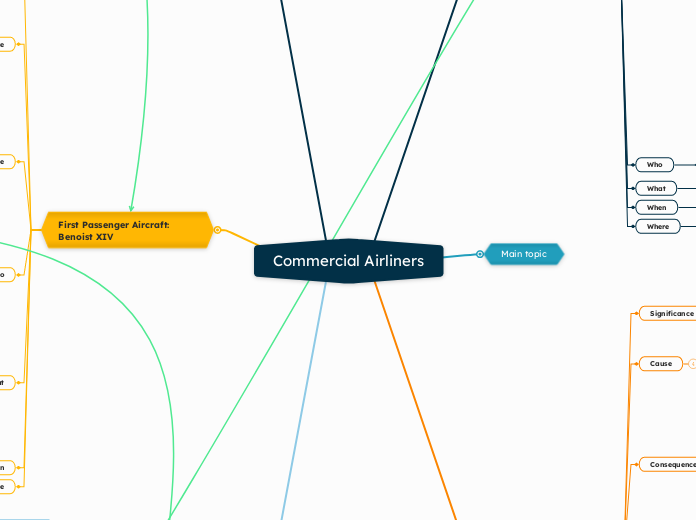The Jet Age
The Propeller Age
Commercial Airliners
First Modern Airliner:
Boeing 247
February 8, 1933
The Boeing 247 was a modern commercial airliner that could carry 10 passengers. It flew 50% faster than the Ford Tri-Motor, the primary passenger aircraft at the time, and could fly across the US in less than 20 hours.
The Boeing 247 was developed by the Boeing Company of Seattle, Washington.
Eventually, it led to the revolutionary introduction of jet engine-powered planes, first seen on the de Havilland Comet in 1949.
Made flying more acceptable for the general public with new safety features.
Paved the way for a new commercial industry of air transport.
The DC-3 was a direct consequence of the development of the Boeing 247. The Douglas Company, the developer of DC-3, was asked by TWA (Trans World Airlines) to develop the plane for them to compete with other airlines that owned Boeing 247s (National Air and Space Museum).
The 247 led the way for other aviation companies to produce modern, high-performancing airliners in the 1930s.
Led to the expansion of the airline industry with United Airlines and Lufthansa taking dozens of orders (Simple Flying).
Airlines also needed bigger, better, and faster airplanes that can serve both passengers and mail. Enhancements to safety equipment on planes were also desperately needed (National Air and Space Museum).
The government incentifised commercial airline development if their aircrafts could fly at night, had multiple engines, two-way radios, and other safety equipment (National Air and Space Museum).
After World War I, airline operators shifted their focus to multi-engine aircraft options due to safety and economical concerns and to fly over water (Simple Flying).
The Boeing 247 was the first modern airliner. Its speed, safety record, and economic performance made the 247 the best plane on the market at the time (Museum of Flight).
First Passenger Aircraft: Benoist XIV
St. Petersburg, Florida and Tampa, Florida
January 1st, 1914 - April 1914
The Benoist XIV had an "impressive" capacity of one passenger, plus its pilot (Smithsonian National Air and Space Museum), but was nevertheless ahead of its time.
The Benoist XIV was designed by Thomas W. Benoist. It was 26 feet long and had a wingspan of 44 feet. Powered by a water-cooled Roberts Motor Company 1913 Model 6-X two-cycle inline six-cylinder engine, it had a maximum speed of 64 miles per hour and a range of 125 miles (Swopes).
Pilot: Tony Jannus, an experienced test pilot
Founder of the Airline: Local businessman Percival E. Fansler
This first passenger air service will eventually lead to the development of one of the most important transportation industries in our world.
Although the Benoist XIV only carried passengers for 4 months, and ceased operations when the government subsidies stopped coming, it was a pioneering milestone for the commercial air transport industry.
As the flight shorted the 2-hour boat ride (or a 20-hour car ride) across Tampa Bay to just under 23 minutes, this air service provided a convenient way for select individuals to get across the bay (Flitetest).
The City of St. Petersburg provided a substantial $2,400 subsidy ($40 per day), under the condition that the airline operate two scheduled flights per day, six days per week, for three months (Swopes).
The Benoist was developed in hopes of carrying a single passenger. It was used as a passenger plane by the St. Petersburg Airboat Lines, founded by local businessman Percival E. Fansler (Swopes).
The Benoist XIV flew under the banner of the St. Petersburg Airboat Lines. It was the first-ever regularly scheduled commercial airline service in the world.
First Airplane:
Wright Flyer
Kitty Hawk, North Carolina
December 17, 1903
The biplane was powered with one 12-horsepower "Wright horizontal four-cylinder engine" and did not have landing gears. It had a wooden structure, with its wings made out of fabric (Klein).
Wilbur and Orville Wright, also known as the Wright Brothers, spent four years researching and developing the "Wright Flyer" (Klein).
The development over the next century and beyond would see humankind break sound barriers, fly above the stratosphere, and even travel around the world with the help of planes.
Just a few short years later, in 1914, the world would see the first scheduled passenger air service in Tampa, known as the Benoist XIV (National Geographic).
The Wright Flyer spurred the development of airplanes. This industry will soon branch off into areas like defense, cargo, and commercial passenger services.
Alberto Santos-Dumont of Brazil and Gustave Whitehead of Connecticut claimed to have flown an airplane before the Wrights, but their claims lacked legitimate documentation (Klein).
The brothers were reportedly fascinated by helicopter-like toys in their childhood, and dreamt of building a flying machine big enough to carry them both (National Geographic).
Humans have always been fascinated by the notion of flying. The earliest blueprint of a flying device was found in
The Wright Flyer was the first successfully flown airplane (Smithsonian National Air and Space Museum), and it was a monumental step in human aviation history.
Affordability Gamechanger: Boeing 747
Seattle, Washington
February 9, 1969
The 747 had a distinct hump on its top and was an icon of 20th century engineering (The Boeing Company).
A total of 1,574 747s were built. The final 747 was built in 2022 after 53 years of production (McGreal).
A jumbo jet that's 2.5 times larger than the typical jetliner at the time, such as the Boeing 707 (Waldek).
The Boeing Company
Developed by a Boeing Team nicknamed "The Incredibles" (due to the fast 29-month concept to rollout speed) and led by Chief Engineer Joe Sutter.
The introduction of the 747 quickly overwhelmed airports around the globe, as they were not used to handling hundreds of passengers per plane. Airports had to quickly expand lounges, check-in counters, and terminals.
The 747 was the first plane to have almost vertical sidewalls and a high ceiling, transforming the crampt image of commercial flying. Its revolutionary design of separating the cabin with galleys and washrooms are still used today (Waldek).
The Boeing 747 changed the economics of widebody operations due to its colossal passenger capacity. The lower costs for intercontinental flying enabled a larger portion of the middle class to fly, contributing significantly to 20th century globalization (Flottau).
The 747 dominated the global airline market for 50 years after its introduction as the standard widebody aircraft (Flottau). However, it was slowly phased out after twin-engine widebodies with more fuel efficiency were introduced.
Boeing aimed to develop a supersonic aircraft to succeed its aging commercial aircraft lineup. However, in March of 1971, the U.S. Congress stopped funding the development of the Boeing 2707, its supersonic plane. This made the 747 the focus of Boeing's development (Simple Aviation).
The design of the 747 was based off of an unproduced high capacity, freight aircraft for military use. The unfinished project lost to the Lockheed C5A Galaxy.
Pan American World Airways (Pan Am) had a great influence on the 747 project, as there were a big customer for the 707. Pan Am pitched their vision of an aircraft over twice the capacity of the 707, which would help lower costs per seat and solve aircraft congestion at major airports (Flottau).
After the launch of the De Havilland Comet and the successful commercialization of the Boeing 707, the jet age was in full bloom. Passenger demands are growing and it was time to develop a new passenger jet.
The 747, nicknamed the "Queen of the Skies," was the world's largest plane until the arrival of the A380 in 2007. As the world’s first twin-aisle airplane, it had a massive capacity of up to 524 passengers (varies depending on the varient), which significantly lowered the cost of plane tickets and enabled more people to fly. revolutionized air travel (McGreal).
Main topic
First Jetliner:
De Havilland Comet
Where
Hatfield, Hertfordshire, England
When
July 27, 1949
What
Development of the first commercial jetliner
Who
Sir Geoffrey de Havilland; The De Havilland Company of England
Consequence
Long-Term
The De Havilland Comet was the aircraft that kicked off the jet age, which lessened the travel time and lowered the costs of air travel (Simple Flying).
The Comet was involved in 3 deadly crashes due to structural problems (Simple Flying). Its deadly design flaws caused long-term pain for the families of those affected but also helped the aviation industry to update its structural protocols.
The Comet was a source of national pride for Britain, as the Boeing company of the US had largely overshadowed all other plane companies during the 20s and 30s. The development of the Comet put the UK in the international aviation spotlight.
Short-Term
The success of the Comet led to the development of rival planes. Boeing soon introduced their jetliner, the Boeing 707; Douglas did the same with the DC-8. These American manufacturers benefited from the PR damage Comet's deadly crashes, and the knowledge that the crash investigations provided. The Comet was never able to recover after its crashes as it had been rendered obsolete by other newer aircraft (Museum of Flight).
The Comet successfully shortened flight time to key international destinations. For example, what once took 86 hours from London to Tokoyo now takes 36 hours with the Comet (Szondy).
Cause
The Comet was a much-needed plane to lessen the air travel time and increase the connectedness of the world.
The Brabazon Committee of the UK was tasked with determining the country's aviation future in the post WWII period (Simple Flying). The group believed that the UK needed a pressurized transatlantic mailplane (Pushkar), which led to the eventual development of the Comet.
Significance
The De Havilland Comet was the first commercial jetliner built (Museum of Flight). As jetliners, the Comets are faster, quieter, and fly higher to avoid turbulence than their propeller-powered counterparts (BAE Systems).









